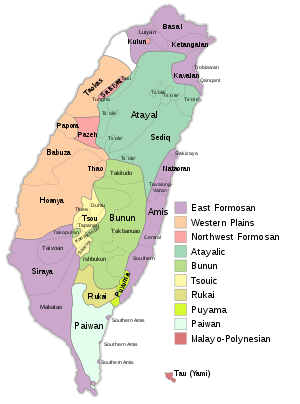List of aboriginal ethnic groups in Taiwan


Traditionally, the Taiwanese indigenous peoples are usually classified into two groups by their places of residence. Languages and cultures of aboriginal tribes were recorded by the government of Dutch Formosa, Spanish Formosa and the Qing Empire.
| Name | Chinese | Taiwanese | Hakka | Japanese (1935–1945) |
|---|---|---|---|---|
| Mountains indigenous peoples | 高山族 | Ko-soaⁿ-cho̍k | Kô-sân-chhu̍k | 高砂族(たかさごぞく, Takasago-zoku) |
| Plains indigenous peoples | 平埔族 | Pêⁿ-po͘-cho̍k | Phìn-phû-chhu̍k | 平埔族(へいほぞく, Heiho-zoku) |
Researches on ethnic groups of Taiwanese indigenous peoples started in late 19th century, when Taiwan was under Japanese rule. The Government of Taiwan (臺灣總督府 Taiwan Sōtokufu) conducted large amount of researches and further distinguished the ethnic groups of Taiwanese indigenous peoples by linguistics (see Formosan languages). After the research, the household registration records remarks of "mountains/plains indigenous peoples". The governmental statistics also listed 9 recognized subgroups under mountains indigenous peoples. However, after World War II, the government refused to recognize the plains indigenous peoples.
The following is a list of classifications through Japanese and post World War II. Note that the Japanese names in parentheses does not exist in pre-World War II Japanese demographic researches.
Mountains indigenous peoples
The Taiwanese government officially recognises 16 ethnic groups of mountains indigenous peoples.
| Name | Formosan native name |
Chinese (after 1945) | Japanese (before 1945) | Notes |
|---|---|---|---|---|
| Amis | Pangcah, 'Amis | 阿美族 | アミ族 | Recognized since Japanese era |
| Atayal | Tayal, Tayan | 泰雅族 | タイヤル族 | Recognized since Japanese era |
| Bunun | Bunun | 布農族 | ブヌン族、ヴォヌム族 | Recognized since Japanese era |
| Kanakanavu | Kanakanavu | 卡那卡那富族 | カナカナブ族 | Classified as Tsou, recognized since 2014 |
| Kavalan | Kebalan, Kbaran | 噶瑪蘭族 | カバラン族 | Classified as Amis, recognized since 2002 |
| Paiwan | Payuan | 排灣族 | パイワン族 | Recognized since Japanese era |
| Puyuma | Pinuyumayan | 卑南族 | プユマ族 | Recognized since Japanese era |
| Rukai | Drekay | 魯凱族 | ルカイ族、ツァリセン族 | Recognized since Japanese era |
| Saaroa | Hla'alua | 拉阿魯哇族 | サアロア族 | Classified as Tsou, recognized since 2014 |
| Saisiyat | Say-Siyat | 賽夏族、獅設族 | サイシャット族 | Recognized since Japanese era |
| Sakizaya | Sakizaya | 撒奇萊雅族 | (サキザヤ族) | Classified as Amis, recognized since 2007 |
| Seediq | Seediq | 賽德克族 | セデック族 | Classified as Atayal, recognized since 2008 |
| Taroko | Truku | 太魯閣族 | (タロコ族) | Classified as Atayal, recognized since 2004 |
| Thao | Thao, Ngan | 邵族 | サオ族 | Classified as Tsou, recognized since 2001 |
| Tsou | Cou | 鄒族、曹族 | ツォウ族、新高族 | Recognized since Japanese era |
| Yami | Tao | 達悟族、雅美族 | ヤミ族 | Recognized since Japanese era |
Kavalan and Thao are disputed to be part of mountains or plains indigenous peoples.
Plains indigenous peoples
Cultures of the plains indigenous peoples have undergone heavy Sinicization. This increases the difficulty in identifying ethnic groups.
| Name | Formosan native name |
Chinese (after 1945) | Japanese (before 1945) | Notes |
|---|---|---|---|---|
| Arikun | Arikun | 阿立昆族 | アリクン族 | Sometimes classified as Hoanya |
| Babuza | Babuza, Poavasa | 貓霧拺族、巴布薩族 | バブザ族 | |
| Basay | Basay, Basai | 巴賽族、馬塞族 | (バサイ族) | Sometimes classified as Ketagalan |
| Hoanya | Hoanya | 洪雅族、和安雅族 | ホアニヤ族 | Sometimes split into Lloa and Arikun |
| Kaxabu | Kaxabu, Kahapu | 噶哈巫族 | (カハブ族) | Sometimes classified as Pazeh. In revitalization. |
| Ketagalan | Ketagalan | 凱達格蘭族 | ケタガラン族 | |
| Kulon | Kulon | 龜崙族 | (クーロン族) | |
| Lloa | Lloa | 羅亞族 | ロッア族 | Sometimes classified Hoanya |
| Luilang | Luilang | 雷朗族 | ルイラン族 | Sometimes classified as Ketagalan |
| Makatao | Makatao, Tao | 馬卡道族 | マカット族、タッオ族 | Sometimes classified as Siraya. Recognized in Pingtung. In revitalization. |
| Papora | Papora, Vupuran | 拍瀑拉族、巴布拉族 | パポラ族 | |
| Pazeh | Pazéh, Pazih | 巴宰族、巴則海族 | パゼッヘ族 | In revitalization. |
| Qauqaut | Qauqaut | 猴猴族 | カウカット族 | |
| Siraya | Siraya | 西拉雅族、希萊耶族 | シラヤ族 | Recognized in Tainan and Fuli. In revitalization. |
| Taivoan | Taivoan, Taivuan | 大武壠族、大滿族 | (タイボアン族) | Sometimes classified as Siraya. Recognized in Fuli. In revitalization. |
| Taokas | Taokas | 道卡斯族、斗葛族、大甲族 | タオカス族 | In revitalization. |